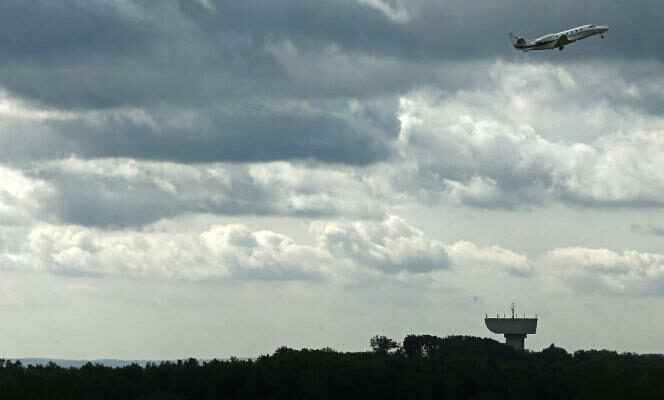This summer, the popular press has seen dozens of articles about the private jets used by Drake, Taylor Swift, Kylie Jenner or Miss France, Diane Leyre. “Taylor Swift accused of polluting too much: the singer spotted hiding while getting out of her private jet”, headlined like this Audience. “Here are the stars who abuse their carbon footprint”, wrote Grace. “Social networks are urging celebrities to get off their private jets”, added She.
At the origin of these criticisms addressed to the stars, the same practice: the flight tracking. It consists of tracking in real time or tracing the movements of planes and private jets from the signals they transmit publicly, thanks to platforms such as ADS-B Exchange, FlightAware or FlightRadar24.
First reserved for a handful of enthusiasts, these sites have seen their popularity skyrocket in recent months. So when US House of Representatives Speaker Nancy Pelosi visited Taiwan in early August, so many people followed on FlightRadar24 the tortuous path from his aircraft that the site had become temporarily inaccessible. Nearly 3 million users tracked the flight of Mme Pelosi, according to statistics from the service, which receives an average of 2 million visits per day.
Because of unprecedented sustained tracking interest in SPAR19, Flightradar24 services are under extremely heavy lo… https://t.co/DJ6rDhjkY9
The “bots” are multiplying
If the pandemic and the war in Ukraine partly explain the growing popularity of flight trackingit is above all the automated accounts created on social networks (“bots”) that have played the role of catalyst of interest, in the first rank of which the @ElonJet account, which echoes on Twitter all the movements of the plane belonging to tech mogul Elon Musk. Far from stopping at this first success – nearly 500,000 followers in two years of existence – its founder, the young American developer Jack Sweeney, has created a myriad of similar accounts allowing, among other things, to follow the movements from Meta boss Mark Zuckerbergof the Russian stateand a whole set billionaires and of celebrities. Adding to each tweet a piece of data missing from the initial project: the carbon footprint. “It was something my subscribers were asking me to add”explained Jack Sweeney in an interview with Worldin May.
Inspired by the experience, other Internet users have launched their own accounts, like @iflybernard (60,000 followers on Twitter) and @laviondebernard (75,000 followers on Instagram and 31,000 on Twitter). Established on the same idea – listing the carbon footprint of each trip of the private jet of Bernard Arnault, first fortune of France and third richest man on the planet – they now follow other planes belonging to large companies and billionaires French, from the Decaux group to Total, including those of Vincent Bolloré, François-Henri Pinault and Martin Bouygues.
“Our intention is to show that a wide range of people continue to use their private jets in the midst of a climate emergency”explain to World the two people behind the @laviondebernard account, who wish to remain anonymous. Because during a summer marked by repeated heat waves and fires, and while the government has been increasing, for several months, calls for energy sobriety to fight against global warming and possible shortages linked to the war in Ukraine, the ecological mismanagement of private jets is going badly.
Social inequalities
“The ecology of small gestures, even if we know that it is essential, that is not what will change the trajectory of climate change”estimates Pierre, who also wished to remain anonymous, a 35-year-old aeronautical engineer at the helm of the @Iflybernard account, who underlines “the very strong link between social inequalities and inequalities in terms of carbon footprint”. And to cite as an example Bernard Arnault and his fifteen round trips Paris-Brussels made in two years, while this trip is easily achievable by train.
All are pleased that, thanks to their publications, the subject has gained momentum on the media scene and triggered the first concrete effects. “LVMH’s F-GVMA jet has stopped flying”thus note the authors of @laviondebernard, according to which this “coincides with the recap of its May flights, which generated a first media buzz”. “We imagine that he rented other planes but already it is a first effect. It seems that you now have to hide a little more when traveling on a jet”jokes on his side Pierre.
The creators of these accounts are aware of the remarks addressed to them in terms of privacy. but sweep the criticismarguing that this flight data is public. “You cannot say that these are private trips and at the same time put your jet in the name of the company”retorts Peter. “If some say our account is a privacy breach, private jet users are a breach of life on earth, period”decide for their part the animators of @laviondebernard.
Their accounts continue in any case to be emulated. Besides similar pages appeared in Italy Where in Norwaya little new christened @YachtCO2tracker appeared in July; this time it aims to highlight another particularly polluting vehicle that the powerful are fond of: yachts.
